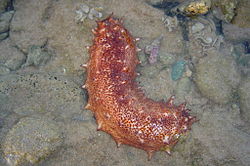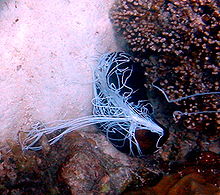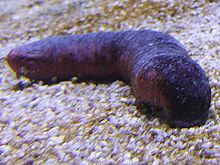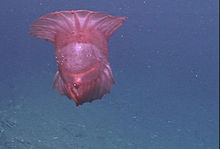- Sea cucumber
-
Sea cucumber 
A sea cucumber from the Mediterranean Sea Scientific classification Kingdom: Animalia Phylum: Echinodermata Subphylum: Echinozoa Class: Holothuroidea
de Blainville, 1834Orders - Subclass Apodacea
- Subclass Aspidochirotacea
- Aspidochirotida
- Elasipodida
- Subclass Dendrochirotacea
Sea cucumbers are echinoderms from the class Holothuroidea. They are marine animals with a leathery skin and an elongated body containing a single, branched gonad. Sea cucumbers are found on the sea floor worldwide. There are a number of holothurian
 /ˌhɒlɵˈθjʊəriən/ species and genera, many of which are targeted for human consumption. The harvested product is variously referred to as trepang, bêche-de-mer or balate.
/ˌhɒlɵˈθjʊəriən/ species and genera, many of which are targeted for human consumption. The harvested product is variously referred to as trepang, bêche-de-mer or balate.Like all echinoderms, sea cucumbers have an endoskeleton just below the skin, calcified structures that are usually reduced to isolated microscopic ossicles (or sclerietes) joined by connective tissue. In some species these can sometimes be enlarged to flattened plates, forming an armour. In pelagic species such as Pelagothuria natatrix (Order Elasipodida, family Pelagothuriidae), the skeleton and a calcareous ring are absent.[1]
Contents
Overview
Sea cucumbers communicate with each other by sending hormone signals through the water.
A remarkable feature of these animals is the catch collagen[Notes 1] that forms their body wall. This can be loosened and tightened at will, and if the animal wants to squeeze through a small gap, it can essentially liquefy its body and pour into the space. To keep itself safe in these crevices and cracks, the sea cucumber will hook up all its collagen fibres to make its body firm again.[2]
Some species of coral-reef sea cucumbers within the order Aspidochirotida can defend themselves by expelling their sticky cuvierian tubules (enlargements of the respiratory tree that float freely in the coelom) to entangle potential predators. When startled, these cucumbers may expel some of them through a tear in the wall of the cloaca in an autotomic process known as evisceration. Replacement tubules grow back in one-and-a-half to five weeks, depending on the species.[3] The release of these tubules can also be accompanied by the discharge of a toxic chemical known as holothurin, which has similar properties to soap. This chemical can kill any animal in the vicinity and is one more way in which these sedentary animals can defend themselves.[2]
They can be found in great numbers on the deep sea floor, where they often make up the majority of the animal biomass.[4] At depths deeper than 5.5 mi (8.8 km), sea cucumbers comprise 90% of the total mass of the macrofauna.[5] Sea cucumbers form large herds that move across the bathygraphic features of the ocean, hunting food. The body of some deep water holothurians is made of a tough gelatinous tissue with unique properties that makes the animals able to control their own buoyancy, making it possible for them to either live on the ocean floor or to actively swim [6] or float over it in order to move to new locations,[7] for instance Enypniastes eximia, Peniagone leander and Paelopatides confundens.[8]
In more shallow waters, sea cucumbers can form dense populations. The strawberry sea cucumber (Squamocnus brevidentis) of New Zealand lives on rocky walls around the southern coast of the South Island where populations sometimes reach densities of 1,000 animals per square metre. For this reason, one such area in Fiordland is simply called the strawberry fields.[9]
A variety of fish, most commonly pearl fish, have evolved a commensalistic symbiotic relationship with sea cucumbers in which the pearl fish will live in sea cucumber's cloaca using it for protection from predation, a source of food (the nutrients passing in and out of the anus from the water), and to develop into their adult stage of life. Many polychaete worms and crabs have also specialized to use the cloacal respiratory trees for protection by living inside the sea cucumber.[10]
The largest American species is Holothuria floridana, which abounds just below low-water mark on the Florida reefs.
Visitors to the Mariana Islands often encounter the local variation, called balate, which litters the sea floor all around the island, including in water as shallow as 3 feet (91 cm). These jet black sea cucumbers are normally 10 to 12 inches (25 to 30 cm) long, 1.5 to 2.0 inches (3.8 to 5.1 cm) in diameter and are often curled up, partially covered with sand from the sea floor.
The most common way to separate the subclasses is by looking at their oral tentacles. Subclass Dendrochirotacea has 8-30 oral tentacles, subclass Aspidochirotacea has 10-30 leaflike or shieldlike oral tentacles, while subclass Apodacea may have up to 25 simple or pinnate oral tentacles and is also characterized by reduced or absent tube feet, as in the order Apodida.[citation needed]
Anatomy
Sea cucumbers are typically 10 to 30 centimetres (3.9 to 12 in) in length, although the smallest known species is just 3 millimetres (0.12 in) long, and the largest can reach 1 metre (3.3 ft). The body ranges from almost spherical to worm-like, and lacks the arms found in many other echinoderms, such as starfish. The anterior end of the animal, containing the mouth, corresponds to the oral pole of other echinoderms (which, in most cases, is the underside), while the posterior end, containing the anus, corresponds to the aboral pole. Thus, compared with other echinoderms, sea cucumbers can be said to be lying on their side.[11]
Diet and digestive system
Holothuroidea are generally scavengers, feeding on debris in the benthic zone of the ocean. Exceptions include pelagic cucumbers and the species Rynkatropa pawsoni, which has a commensal relationship with deep-sea anglerfish.[12] The diet of most cucumbers consists of plankton and decaying organic matter found in the sea. Some sea cucumbers position themselves in currents and catch food that flows by with their open tentacles. They also sift through the bottom sediments using their tentacles. Other species can dig into bottom silt or sand until they are completely buried. They then extrude their feeding tentacles, ready to withdraw at any hint of danger.
A pharynx lies behind the mouth and is surrounded by a ring of ten calcareous plates. In most sea cucumbers, this is the only substantial part of the skeleton, and it forms the point of attachment for muscles that can retract the tentacles into the body for safety as for the main muscles of the body wall. Many species possess an oesophagus and stomach, but in some the pharynx opens directly into the intestine. The intestine is typically long and coiled, and loops through the body three times before terminating in a cloacal chamber, or directly as the anus.[11]
Nervous system
Sea cucumbers have no true brain. A ring of neural tissue surrounds the oral cavity, and sends nerves to the tentacles and the pharynx. The animal is, however, quite capable of functioning and moving about if the nerve ring is surgically removed, demonstrating that it does not have a central role in nervous coordination. In addition, five major nerves run from the nerve ring down length of the body beneath each of the ambulacral areas.[11]
Most sea cucumbers have no distinct sensory organs, although there are various nerve endings scattered through the skin giving the animal a sense of touch and a sensitivity to the presence of light. There are, however, a few exceptions; members of the Apodida order are known to possess statocysts, while some species possess small eye-spots near the bases of their tentacles.[11]
Respiratory system
Sea cucumbers extract oxygen from water in a pair of 'respiratory trees' that branch off the cloaca just inside the anus, so that they 'breathe' by drawing water in through the anus and then expelling it.[13][14] The trees consist of a series of narrow tubules branching from a common duct, and lie on either side of the digestive tract. Gas exchange occurs across the thin walls of the tubules, to and from the fluid of the main body cavity.
Together with the intestine, the respiratory trees also act as excretory organs, with nitrogenous waste diffusing across the tubule walls in the form of ammonia and phagocytic coelomocytes depositing particulate waste.[11]
Circulatory systems
Like all echinoderms, sea cucumbers possess both a water vascular system that provides hydraulic pressure to the tentacles and tube feet, allowing them to move, and a haemal system. The latter is more complex than that in other echinoderms, and consists of well-developed vessels as well as open sinuses.[11]
A central haemal ring surrounds the pharynx next to the ring canal of the water vascular system, and sends off additional vessels along the radial canals beneah the ambulacral areas. In the larger species, additional vessels run above and below the intestine and are connected by over a hundred small muscular ampullae, acting as miniature hearts to pump blood around the haemal system. Additional vessels surround the respiratory trees, although they contact them only indirectly, via the coelomic fluid.[11]
Indeed, the blood itself is essentially identical with the coelomic fluid that bathes the organs directly, and also fills the water vascular system. Phagocytic coelomocytes, somewhat similar in function to the white blood cells of vertebrates, are formed within the haemal vessels, and travel throughout the body cavity as well as both circulatory systems. An additional form of coelomocyte, not found in other echinoderms, has a flattened discoid shape, and contains haemoglobin. As a result, in many (though not all) species, both the blood and the coelomic fluid are red in colour.[11]
Vanadium has been reported in high concentrations in holothurian blood,[15] however researchers have been unable to reproduce these results.[16]
Locomotion and exoskeleton
Like all echinoderms, sea cucumbers possess pentaradial symmetry. However, because of their posture, they have secondarily evolved a degree of bilateral symmetry. For example, because one side of the body is typically pressed against the substratum, and the other is not, there is usually some difference between the two surfaces. Like sea urchins, most sea cucumbers have five strip-like ambulacral areas running along the length of the body from the mouth to the anus. The three on the lower surface have numerous tube feet, often with suckers, that allow the animal to crawl along. The two on the upper surface have under-developed or vestigial tube feet, and, in some species, lack tube feet altogether.[11]
In some species, the ambulacral areas can no longer be distinguished, with tube feet spread over a much wider area of the body. Those of the subclass Apodacea have no tube feet or ambulacral areas at all, and burrow through sediment with muscular contractions of their body.[11]
However, even in those sea cucumbers that lack regular tube feet, those immediately around the mouth are always present. These are highly modified into retractile tentacles, much larger than the regular tube feet. Sea cucumbers have between ten and thirty such tentacles, depending on the species.[11]
Many sea cucumbers have papillae, conical fleshy projections of the body wall with sensory tube feet at their apices.[17]
Echinoderms typically possess an internal skeleton composed of plates of calcium carbonate. In most sea cucumbers, however, these have become reduced to microscopic ossicles embedded beneath the skin. A few genera, such as Sphaerothuria, retain relatively large plates, giving them a scaly armour.[11]
Reproduction and life cycle
Most sea cucumbers reproduce by releasing sperm and ova into the ocean water. Depending on conditions, one organism can produce thousands of gametes. Sea cucumbers are typically dioecious, with separate male and female individuals, but some species are protandric. The reproductive system consists of a single gonad, consisting of a cluster of tubules emptying into a single duct that opens on the upper surface of the animal, close to the tentacles.[11]
At least 30 species, including the red-chested sea cucumber (Pseudocnella insolens), fertilise their eggs internally and then pick up the fertilised zygote with one of their feeding tentacles. The egg is then inserted into a pouch on the adult's body, where it develops and eventually hatches from the pouch as a juvenile sea cucumber.[18] A few species are known to brood their young inside the body cavity, giving birth through a small rupture in the body wall close to the anus.[11]
In all other species, the egg develops into a free-swimming larva, typically after around three days of development. The first stage of larval development is known as an auricularia, and is only around 1 millimetre (0.039 in) in length. This larva swims by means of a long band of cilia wrapped around its body, and somewhat resembles the bipinnaria larva of starfish. As the larva grows it transforms into the doliolaria, with a barrel-shaped body and three to five separate rings of cilia. The tentacles are usually the first adult features to appear, before the regular tube feet.[11]
Holothurians as food and medicine
To supply the markets of Southern China, Macassan trepangers traded with the Indigenous Australians of Arnhem Land. This Macassan contact with Australia is the first recorded example of trade between the inhabitants of the Australian continent and their Asian neighbours.[19]
There are many commercially important species of sea cucumber that are harvested and dried for export for use in Chinese cuisine as Hoi sam. Some of the more commonly found species in markets include:[20]
- Holothuria scabra
- Holothuria fuscogilva
- Actinopyga mauritiana
- Stichius japonicus
- Parastichopus californicus
- Thelenota ananas
- Acaudina molpadioides
- Isostichopus fuscus
Some varieties of sea cucumber (known as gamat in Malaysia or teripang in Indonesia) are said to have excellent healing properties.[citation needed] There are pharmaceutical companies being built based on gamat. Extracts are prepared and made into oil, cream, or cosmetics. Some products are intended to be taken internally. A single study conducted on an unreported number of mice found intraperitoneal injection of sea cucumber extract to be somewhat effective in high doses (100 mg/kg) against internal pain, but ineffective against externally induced pain.[21] Another study suggested that the sea cucumber contains all the fatty acids necessary to play a potential active role in tissue repair.[22]
On December 21, 2007, a study published in PLoS Pathogens found that a lectin from Cucumaria echinata impaired the development of the malaria parasite when produced by transgenic mosquitoes.[23]
Commercial harvest
In recent years, the sea cucumber industry in Alaska has increased due to increased export of the skins and muscles to China.[24]
In China, many commercial sea cucumbers are farmed in artificial ponds. These ponds can be as large as 1,000 acres (4.0 km2), and satisfy much of the local demand.[24] Wild sea cucumbers are caught by divers and these wild Alaskan sea cucumbers have higher nutritional value and are larger than farmed Chinese sea cucumbers. Larger size and higher nutritional value has allowed the Alaskan fisheries to continue to compete for market shares, despite the increase in local, Chinese sea cucumber farming.[24]
Aquaculture
Main article: Aquaculture of sea cucumberOverexploitation of sea cucumber stocks in many parts of the world, provided motivation for the development of sea cucumber aquaculture in the early 1980s. The Chinese and Japanese were the first to develop successful hatchery technology on Apostichopus japonicus, prized for its high meat content and success in commercial hatcheries.[25] A second species, Holothuria scabra, was cultured for the first time using the techniques pioneered by the Chinese and Japanese for by India in 1988.[26] In recent years Australia, Indonesia, New Caledonia, Maldives, Solomon Islands and Viet Nam have also successfully cultured H. scabra using the same technology and has since been expanded to other species.[25]
In art and literature
Sea cucumbers have inspired thousands of haiku in Japan, where they are called namako (海鼠), written with characters that can be translated "sea mice" (an example of gikun). In English translations of these haiku, they are usually called "sea slugs". According to the Oxford English Dictionary, the English term "sea slug" was originally applied to holothurians during the 18th century. The term is now applied to several groups of sea snails, marine gastropod mollusks that have no shell or only a very reduced shell, including the nudibranchs. Almost 1,000 Japanese holothurian haiku translated into English appear in the book Rise, Ye Sea Slugs! by Robin D. Gill.[27]
See also
Notes
- ^ "Catch" collagen has two states, soft and stiff, that are under neurological control. Jose del Castillo and David S. Smith. (1996) "We Still Invoke Friction and Occam's Razor to Explain Catch in the Spines of Eucidaris Tribuloides." Biological Bulletin 190:243-244
Citations
- ^ Reich, Mike (30–31 January 2006). Lefebvre, B.; David, B.; Nardin, E. & Poty, E.. ed. "Cambrian holothurians ? – The early fossil record and evolution of Holothuroidea". Journées Georges Ubaghs (Dijon, France: Université de Bourgogne): 36–37. http://www.geobiologie.uni-goettingen.de/people/mreich/pdf/PDFs/POST_Dijon_Seegurken1.pdf.
- ^ a b Piper, Ross (2007). Extraordinary Animals: An Encyclopedia of Curious and Unusual Animals. Greenwood Press. ISBN 0313339228.
- ^ Flammang, Patrick; Ribesse, Jerome & Jangoux, Michel (2002-12-01). "Biomechanics of adhesion in sea cucumber cuvierian tubules (echinodermata, holothuroidea)". Integrative and Comparative Biology 42 (6): 1107–1115. doi:10.1093/icb/42.6.1107. PMID 21680394. http://icb.oxfordjournals.org/cgi/content/abstract/42/6/1107. Retrieved 2007-10-03.
- ^ Miller, Nat. "Sea Cucumbers". http://jrscience.wcp.muohio.edu/fieldcourses05/PapersMarineEcologyArticles/SeaCucumbers.html. Retrieved 2007-10-03.
- ^ Sci-Tech Encyclopedia: Holothuroidea
- ^ Blue Planet Discovery Channel
- ^ Carney, Bob (2007-06-18). "The Kingdom of the Echinoderm". http://www.oceanexplorer.noaa.gov/explorations/07mexico/logs/june18/june18.html. Retrieved 2007-10-03.
- ^ Deep-sea demersal fish zone
- ^ Alcock, Niki (2003). "Shedding new light on the humble sea cucumber". Aquatic Biodiversity & Biosecurity Update (New Zealand: National Institute of Water and Atmospheric Research) (3). http://www.niwa.co.nz/news-and-publications/publications/all/abb/2003-03/cucumber. Retrieved 2007-10-03.
- ^ Toonen, Rob, Ph.D. (March 2003). "Aquarium Invertebrates". Advanced Aquarist's Online Magazine 2 (3). http://www.advancedaquarist.com/issues/mar2003/invert.htm. Retrieved 2007-10-03.
- ^ a b c d e f g h i j k l m n o Barnes, Robert D. (1982). Invertebrate Zoology. Philadelphia, PA: Holt-Saunders International. pp. 981–997. ISBN 0-03-056747-5.
- ^ Brusca, R.C.; Brusca, G.J. (1990). Invertebrates. Massachusetts: Sinauer Associates. ISBN 0-87893-097-3.
- ^ "Holothurians or sea cucumbers". http://www.fegi.ru/prim/sea/golot.htm. Retrieved 2007-10-03.
- ^ Ingram, Jocie (2006-06-16). "Knowing Nature... Cool as a Sea Cucumber". http://www.comoxvalleynaturalist.bc.ca/knowing_nature/2006/sea_cucumbers.html. Retrieved 2007-10-03.
- ^ Phillips, Alexander (1918). A Possible Source of Vanadium in Sedimentary Rocks. Princeton University. http://books.google.com/books?id=O6KxwrrC_LMC&pg=PA473&dq=possible+sources+of+vanadium+in+sedimentary+rock#v=onepage&q&f=false.
- ^ Ciereszko, L.; Ciereszko, E; Harris, E; Lane, C (1962). "On the Occurrence of Vanadium in Holothurians". Comparative Biochemistry and Physiology (Comparative Biochemistry and Physiology) 7: 127–9. doi:10.1016/0010-406X(62)90034-8. PMID 14021342. http://www.sciencedirect.com/science?_ob=ArticleURL&_udi=B73GK-4865B65-HJ&_user=10&_coverDate=10/31/1962&_rdoc=1&_fmt=high&_orig=search&_sort=d&_docanchor=&view=c&_searchStrId=1417835943&_rerunOrigin=google&_acct=C000050221&_version=1&_urlVersion=0&_userid=10&md5=bad047547fdf62971a80abc78fe303d8.
- ^ Marine Species Identification Portal
- ^ Branch GM, Griffiths CL, Branch ML and Beckley LE (2005) Two Oceans ISBN 0-86486-672-0
- ^ Tippett, A. R.. The Voyage to Marege: Macassan Trepangers in Northern Australia.
- ^ Ramofafia C., Byrne M., Battaglene S. C (2003). "Development of three commercial sea cucumbers, Holothuria scabra, H. fuscogilva and Actinopyga mauritiana: larval structure and growth". Marine and freshwater research 54 (5): 657–667. doi:10.1071/MF02145. ISSN 1323-1650.
- ^ B.H. Ridzwan , T.C. Leong and S.Z. Idid (2003). "The Antinociceptive Effects of Water Extracts from Sea Cucumbers Holothuria leucospilota Brandt, Bohadschia marmorata vitiensis Jaeger and Coelomic Fluid from Stichopus hermanii". Pakistan Journal of Biological Sciences 6 (24): 2068–2072. doi:10.3923/pjbs.2003.2068.2072. http://docsdrive.com/pdfs/ansinet/pjbs/2003/2068-2072.pdf.
- ^ B. D. Fredalina, B. H. Ridzwan, A. A. Zainal Abidin, M. A. Kaswandi, H. Zaiton, I. Zali, P. Kittakoop and A. M. Mat Jais (October 1999). "Fatty acid compositions in local sea cucumber, Stichopus chloronotus, for wound healing". General pharmacology 33 (4): 337–340. doi:10.1016/S0306-3623(98)00253-5. PMID 10523072.
- ^ Yoshida S, Shimada Y, Kondoh D et al. (2007). "Hemolytic C-Type Lectin CEL-III from Sea Cucumber Expressed in Transgenic Mosquitoes Impairs Malaria Parasite Development". PLoS Pathog. 3 (12): e192. doi:10.1371/journal.ppat.0030192. PMC 2151087. PMID 18159942. http://www.plospathogens.org/article/info:doi/10.1371/journal.ppat.0030192.
- ^ a b c Ess, Charlie. "Wild product’s versatility could push price beyond $2 for Alaska dive fleet". National Fisherman. http://www.nationalfisherman.com/2008.asp?ItemID=1800&pcid=373&cid=375&archive=yes. Retrieved 2008-08-01.
- ^ a b James, B. D. (2004). Captive breeding of the sea cucumber, Holothuria scabra, from India. In Lovatelli, A. (comp./ed.); Conand, C.; Purcell, S.; Uthicke, S.; Hamel, J.-F.; Mercier, A. (eds.) Advances in sea cucumber aquaculture and management. FAO Fisheries Technical Paper. No. 463. Rome, FAO. 2004. 425p.
- ^ James, D. B., Gandhi, A. D., Palaniswamy, N., & Rodrigo, J. X. (1994). Techniques and Culture of the Sea-cucumber Holothuria scabra. CMFRI Special Publication(57), 1-40.
- ^ Gill, Robin D. Rise, Ye Sea Slugs!. Paraverse Press, 2003, ISBN 0-9742618-0-7
Principal commercial fishery species groups Wild Forage fishOther wild fishMolluscs- Sea cucumbers
- Sea urchin
- more...



Farmed Categories:- Holothuroidea
- Echinoderms
- Edible shellfish
- Commercial echinoderms
- Chinese ingredients
- Korean ingredients
- Fauna of Japan
- Japanese seafood
- Seafood
- Indonesian cuisine
Wikimedia Foundation. 2010.







